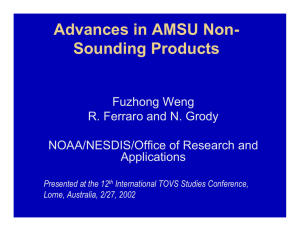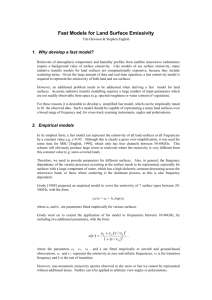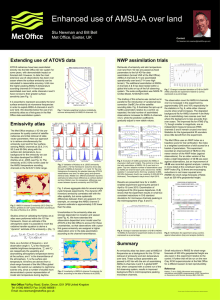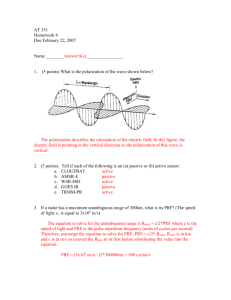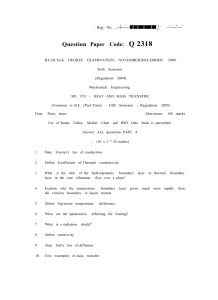Are microwave surface emissivity models good enough to fully
advertisement
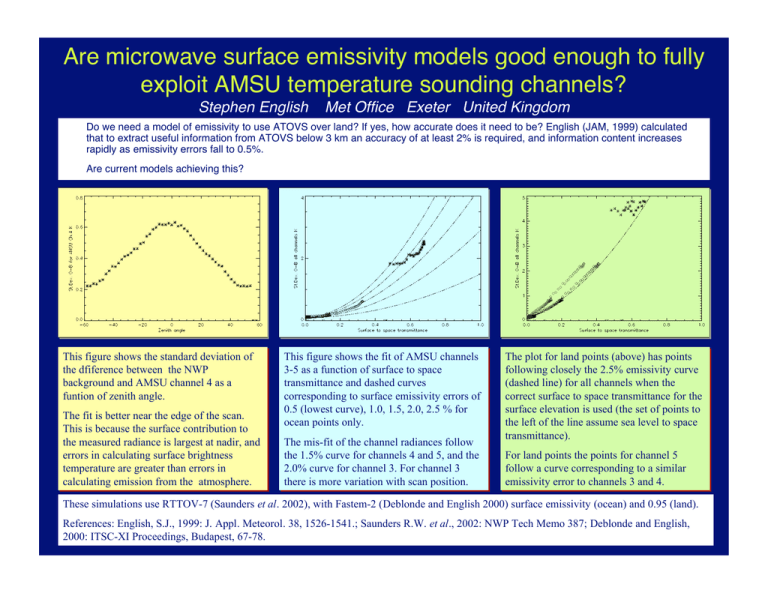
Are microwave surface emissivity models good enough to fully exploit AMSU temperature sounding channels? Stephen English Met Office Exeter United Kingdom Do we need a model of emissivity to use ATOVS over land? If yes, how accurate does it need to be? English (JAM, 1999) calculated that to extract useful information from ATOVS below 3 km an accuracy of at least 2% is required, and information content increases rapidly as emissivity errors fall to 0.5%. Are current models achieving this? This This figure figure shows shows the the standard standard deviation deviation of of the the dfiference dfiference between between the the NWP NWP background background and and AMSU AMSU channel channel 44 as as aa funtion funtion of of zenith zenith angle. angle. The The fit fit is is better better near near the the edge edge of of the the scan. scan. This This is is because because the the surface surface contribution contribution to to the measured radiance is largest at nadir, the measured radiance is largest at nadir, and and errors errors in in calculating calculating surface surface brightness brightness temperature temperature are are greater greater than than errors errors in in calculating calculating emission emission from from the the atmosphere. atmosphere. This This figure figure shows shows the the fit fit of of AMSU AMSU channels channels 3-5 3-5 as as aa function function of of surface surface to to space space transmittance transmittance and and dashed dashed curves curves corresponding corresponding to to surface surface emissivity emissivity errors errors of of 0.5 0.5 (lowest (lowest curve), curve), 1.0, 1.0, 1.5, 1.5, 2.0, 2.0, 2.5 2.5 % % for for ocean ocean points points only. only. The The mis-fit mis-fit of of the the channel channel radiances radiances follow follow the the 1.5% 1.5% curve curve for for channels channels 44 and and 5, 5, and and the the 2.0% curve for channel 3. For channel 3 2.0% curve for channel 3. For channel 3 there there is is more more variation variation with with scan scan position. position. The The plot plot for for land land points points (above) (above) has has points points following following closely closely the the 2.5% 2.5% emissivity emissivity curve curve (dashed line) for all channels when the (dashed line) for all channels when the correct correct surface surface to to space space transmittance transmittance for for the the surface surface elevation elevation is is used used (the (the set set of of points points to to the left of the line assume sea level to space the left of the line assume sea level to space transmittance). transmittance). For For land land points points the the points points for for channel channel 55 follow a curve corresponding to follow a curve corresponding to aa similar similar emissivity emissivity error error to to channels channels 33 and and 4. 4. These simulations use RTTOV-7 (Saunders et al. 2002), with Fastem-2 (Deblonde and English 2000) surface emissivity (ocean) and 0.95 (land). References: English, S.J., 1999: J. Appl. Meteorol. 38, 1526-1541.; Saunders R.W. et al., 2002: NWP Tech Memo 387; Deblonde and English, 2000: ITSC-XI Proceedings, Budapest, 67-78. The analysis of the fit of radiances to background suggests emissivity errors of 1.5% for the ocean emissivity model. Land surface emissivity errors using a fixed emissivity of 0.95 are around 2.5%. This falls well short of the 0.5% emissivity errors required to fully exploit ATOVS, and explains why fit to background is worst near nadir for surface sensing channels. However for oceans it is better than the 2% minimum requirement. For land it is not good enough. Given Given these these errors errors in in surface surface emissivity emissivity model model which which channels channels can can be be used? used? The The error error arising arising from from errors errors in in surface surface emissivity emissivity can can be be compared compared with with errors errors arising arising from from errors errors in in the the background background tmperature, tmperature, expressed expressed as as the the Hessian Hessian of of the the T T cost cost function, function, HBH HBH .. The The plot plot above above shows shows emissivity emissivity errors errors of of 0.2% 0.2% (lowest), (lowest), 0.5%, 0.5%, 1.0%, 1.0%, 1.5%, 1.5%, 2.0%, 2.0%, 5.0% 5.0% as as dotted dotted lines lines and and background background temperature temperature errors errors as as continuous continuous lines lines (for (for AMSU AMSU channels channels 6, 6, 5, 5, 4, 4, 33 from from left left to to right), right), as as aa function function of of surface surface to to space space transmittance. transmittance. For For AMSU AMSU channel channel 66 emissivity emissivity errors errors in in excess excess of of 5% 5% are are tolerable tolerable for for most most of of the the scan. scan. Therefore Therefore AMSU AMSU channel channel 66 can can be be used used over over most most land land surfaces surfaces most most of of the the time, time, without without the the need need for for an an emissivity emissivity model. model. For For AMSU AMSU channel channel 55 emissivity emissivity errors errors of of 5% 5% are tolerable at the edge of the scan, but only are tolerable at the edge of the scan, but only 1% 1% near near nadir. nadir. Therefore Therefore part part of of the the scan scan could be used for AMSU channel 5 without could be used for AMSU channel 5 without aa more more accurate accurate model, model, but but near near nadir nadir the the use use of of AMSU AMSU channel channel 55 is is sub-optimal, sub-optimal, even even over over the oceans. For AMSU channel 4 an the oceans. For AMSU channel 4 an emissivity emissivity error error of of 0.2-0.5% 0.2-0.5% is is required, required, depending depending on on scan scan position, position, which which is is beyond beyond the the capability capability of of current current models, models, even even over over the the ocean. ocean. AMSU AMSU channel channel 33 has has negligible negligible information information content content for for atmospheric atmospheric temperature. temperature. Are microwave surface emissivity models good enough to fully exploit AMSU temperature sounding channels? © Crown copyright 2003 Conclusions • Emissivity models are not good enough to be able to exploit the atmospheric temperature sensitivity of AMSU channel 4. • Surface emissivity errors are around 1.5% for the ocean and 2.5% for land. • The outer edges of the AMSU channel 5 scan could be used over all surfaces (if cloud detection is adequate), whereas near nadir this channel is unlikely to be useful even over oceans. • Account should be taken of the variation of RT error with scan position when processing AMSU.


